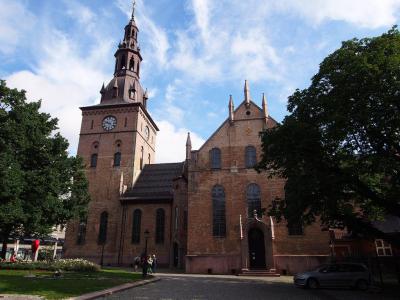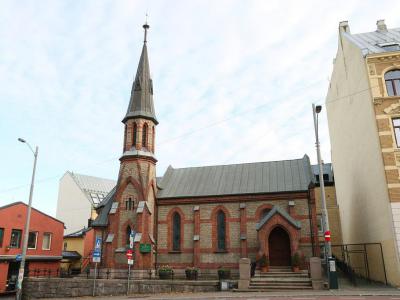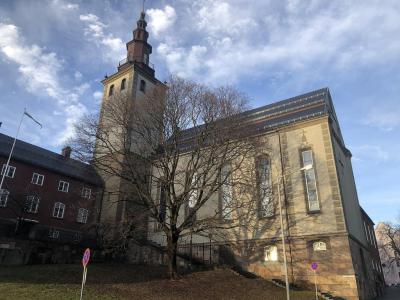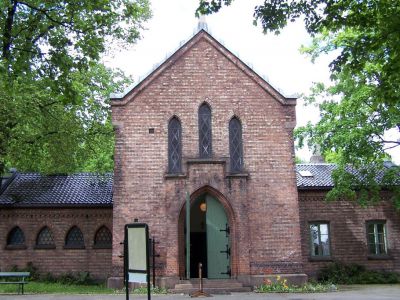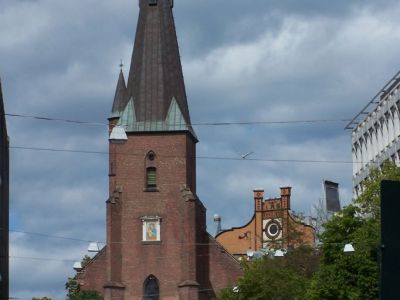Historical Churches Walking Tour (Self Guided), Oslo
Oslo's religious landscape, particularly within the Christian tradition, is a captivating tapestry interwoven with history, faith, and architectural elegance. The city boasts a collection of historical churches reflecting the evolution of local Christian communities. Diverse in their designs, these sacred sites offer a glimpse into the deep-rooted religious traditions that have shaped Oslo over the centuries.
Oslo Cathedral (Oslo Domkirke), the city's main temple, represents the Church of Norway and is a striking example of Baroque architecture. The history of this religious site dates back to the 12th century, while the current building appeared some 500 years later.
Trinity Church (Trefoldighetskirken): This Gothic Revival beauty of the Lutheran denomination stands proudly with its Medieval temple-inspired design and was completed in the 1850s.
Similar to it in terms of Neo-Gothic appearance, Saint Olav's Roman Catholic Cathedral is the principal Catholic church in Oslo. Its presence is a testament to the enduring Catholic community in the city.
The Maria Bebudelses Orthodox Church represents the Orthodox Christian faith. Its somewhat quirky façade adds a unique touch to the city's ecclesiastical scene.
The Saint James Cultural Church (Kulturkirken Jakob), originally built as a Lutheran sanctuary, today serves as a vibrant cultural center. Its diverse events and activities make it a hub for artistic and spiritual expression.
Further reflecting the city's cosmopolitan character is the quaint Anglican Saint Edmund's Church. Its simple yet charming design invites people from various backgrounds to share in its spiritual warmth.
In turn, the Swedish Margaret Church (Svenska Margaretakyrkan) serves as a spiritual home for the Church of Sweden community of Oslo. This building showcases a blend of Scandinavian and Gothic architectural styles.
Visiting these historical churches is not just an exploration of faith and history but also a chance to experience the diverse heritage of Oslo and, perhaps, understand its soul. If you wish to learn more about the religious life of the beautiful Norwegian capital, take this self-guided walking tour.
Oslo Cathedral (Oslo Domkirke), the city's main temple, represents the Church of Norway and is a striking example of Baroque architecture. The history of this religious site dates back to the 12th century, while the current building appeared some 500 years later.
Trinity Church (Trefoldighetskirken): This Gothic Revival beauty of the Lutheran denomination stands proudly with its Medieval temple-inspired design and was completed in the 1850s.
Similar to it in terms of Neo-Gothic appearance, Saint Olav's Roman Catholic Cathedral is the principal Catholic church in Oslo. Its presence is a testament to the enduring Catholic community in the city.
The Maria Bebudelses Orthodox Church represents the Orthodox Christian faith. Its somewhat quirky façade adds a unique touch to the city's ecclesiastical scene.
The Saint James Cultural Church (Kulturkirken Jakob), originally built as a Lutheran sanctuary, today serves as a vibrant cultural center. Its diverse events and activities make it a hub for artistic and spiritual expression.
Further reflecting the city's cosmopolitan character is the quaint Anglican Saint Edmund's Church. Its simple yet charming design invites people from various backgrounds to share in its spiritual warmth.
In turn, the Swedish Margaret Church (Svenska Margaretakyrkan) serves as a spiritual home for the Church of Sweden community of Oslo. This building showcases a blend of Scandinavian and Gothic architectural styles.
Visiting these historical churches is not just an exploration of faith and history but also a chance to experience the diverse heritage of Oslo and, perhaps, understand its soul. If you wish to learn more about the religious life of the beautiful Norwegian capital, take this self-guided walking tour.
How it works: Download the app "GPSmyCity: Walks in 1K+ Cities" from Apple App Store or Google Play Store to your mobile phone or tablet. The app turns your mobile device into a personal tour guide and its built-in GPS navigation functions guide you from one tour stop to next. The app works offline, so no data plan is needed when traveling abroad.
Historical Churches Walking Tour Map
Guide Name: Historical Churches Walking Tour
Guide Location: Norway » Oslo (See other walking tours in Oslo)
Guide Type: Self-guided Walking Tour (Sightseeing)
# of Attractions: 5
Tour Duration: 1 Hour(s)
Travel Distance: 1.2 Km or 0.7 Miles
Author: DanaOffice
Sight(s) Featured in This Guide:
Guide Location: Norway » Oslo (See other walking tours in Oslo)
Guide Type: Self-guided Walking Tour (Sightseeing)
# of Attractions: 5
Tour Duration: 1 Hour(s)
Travel Distance: 1.2 Km or 0.7 Miles
Author: DanaOffice
Sight(s) Featured in This Guide:
- Oslo Cathedral
- St. Edmund's Church
- Svenska Margaretakyrkan (Swedish Margaret Church)
- Maria Bebudelses Orthodox Church
- Saint Olav's Roman Catholic Cathedral
1) Oslo Cathedral
Oslo Cathedral (Oslo Domkirke), previously known as Our Savior's Church (Vår Frelsers Kirke), is the main temple of the Church of Norway. Located at Stortorvet square, near Karl Johans gate, the current cathedral – Oslo's third cathedral in total – was constructed between 1694 and 1697. The first one, Hallvards Cathedral, was established in the 12th century by King Sigurd I but fell into disrepair after the city was moved closer to Akershus Fortress following a fire in 1624. The second cathedral, Holy Trinity, lasted only 50 years before burning down, prompting the need to build a new one.
This elegant, if somewhat unassuming, neo-Gothic edifice has served as a religious center but also as a venue for significant national events such as royal weddings and public ceremonies. In 2001, it hosted Norway’s latest royal wedding – of Crown Prince Haakon and Mette Tjessem Hoiby. Following a major renovation in 2010, the cathedral reopened with a high mass attended by the members of the Norwegian royal family led by King Harald V.
The architecture features a blend of red brick construction with green copper accents, notably on the adjoining Bazaar and the Fire Watch buildings. Internally, the cathedral houses several art pieces including stained-glass windows by Emanuel Vigeland, silver sculpture by Arrigo Minerbi, bronze doors by Dagfin Werenskiold, and elaborate ceiling decoration by Norwegian painter Hugo Mohr.
The cathedral's main organ was installed in 1997 to mark its 300th anniversary. Since December 2016, the cathedral's carillon has been in regular use for hour- and quarter-strokes, as well as ritornelles, playing 18 different melodies between 7:00 am and midnight, changing according to the calendar. The church holds Mass every Sunday and is free to visit throughout the week. Guided group tours can also be arranged on weekdays.
This elegant, if somewhat unassuming, neo-Gothic edifice has served as a religious center but also as a venue for significant national events such as royal weddings and public ceremonies. In 2001, it hosted Norway’s latest royal wedding – of Crown Prince Haakon and Mette Tjessem Hoiby. Following a major renovation in 2010, the cathedral reopened with a high mass attended by the members of the Norwegian royal family led by King Harald V.
The architecture features a blend of red brick construction with green copper accents, notably on the adjoining Bazaar and the Fire Watch buildings. Internally, the cathedral houses several art pieces including stained-glass windows by Emanuel Vigeland, silver sculpture by Arrigo Minerbi, bronze doors by Dagfin Werenskiold, and elaborate ceiling decoration by Norwegian painter Hugo Mohr.
The cathedral's main organ was installed in 1997 to mark its 300th anniversary. Since December 2016, the cathedral's carillon has been in regular use for hour- and quarter-strokes, as well as ritornelles, playing 18 different melodies between 7:00 am and midnight, changing according to the calendar. The church holds Mass every Sunday and is free to visit throughout the week. Guided group tours can also be arranged on weekdays.
2) St. Edmund's Church
Saint Edmund’s Church is an Anglican place of worship, with a predominantly English speaking congregation. The church has had a presence in the city since the mid 19th century. The current building located on Møllersgata was dedicated in 1883, and consecrated by the Bishop of Fulham. Whilst the church belongs in theory to the Church of England, it hosts worshipers from Anglophone nations around the world. Each Sunday, Saint Edmund’s congregation is made up of nationals from over twenty countries, making it one of Oslo’s most diverse churches. The Sunday service takes place at 11am, with an informal coffee morning taking place afterwards.
A compact neo-Gothic design, the church is often referred to as a miniature cathedral. Designed by architect Paul Due, it is known for its stained glass windows and ornate central spire, which stand out in a fairly drab corner of the city. The church is a welcoming city center place of worship, and hosts a Junior Church, student group and women only events. There is also a choir who host regular recitals. Saint Edmund’s Church is the popular choice for Christians visiting Oslo from other countries, or migrants looking for a new place of worship in Norway.
A compact neo-Gothic design, the church is often referred to as a miniature cathedral. Designed by architect Paul Due, it is known for its stained glass windows and ornate central spire, which stand out in a fairly drab corner of the city. The church is a welcoming city center place of worship, and hosts a Junior Church, student group and women only events. There is also a choir who host regular recitals. Saint Edmund’s Church is the popular choice for Christians visiting Oslo from other countries, or migrants looking for a new place of worship in Norway.
3) Svenska Margaretakyrkan (Swedish Margaret Church)
Svenska Margaretakyrkan, which translates as The Swedish Margaret Church, is found on Hammersborg Torg, north of the city center and close to many of Oslo’s most visited churches. Immediately adjacent to the Deichmanske municipal library, the church is a mortar-coated white brick building in the neoclassical style, topped with a bronze spire at its center. Created as a Swedish church, it was designed by Lars Israel Wahlman, and built in 1922. The church was consecrated by Bishop Nathan Söderblom in December 1925. The main altarpiece, depicting Christ’s Sermon on the Mount, was designed by Gunnar Torhamn.
Currently housing a predominantly Swedish congregation, this elegant church still holds regular services, on Sundays and weekday evenings. The church is perhaps best known in Oslo for its efforts during World War 2. With Norway under attack from Nazi Germany, the church provided food to a large portion of the city’s population. It is believed that over 7000 people came to Saint Margaret’s every day for food – most famously, the low-cost ‘Swedish soup’ that the church regularly served to the hungry citizens of Oslo. The church building is also known for its excellent acoustics, and choral recitals are often held here as a result.
Currently housing a predominantly Swedish congregation, this elegant church still holds regular services, on Sundays and weekday evenings. The church is perhaps best known in Oslo for its efforts during World War 2. With Norway under attack from Nazi Germany, the church provided food to a large portion of the city’s population. It is believed that over 7000 people came to Saint Margaret’s every day for food – most famously, the low-cost ‘Swedish soup’ that the church regularly served to the hungry citizens of Oslo. The church building is also known for its excellent acoustics, and choral recitals are often held here as a result.
4) Maria Bebudelses Orthodox Church
Maria Bebudelses Kirke, or Saint Mary of the Annunciation Church, is a small, unusual place of worship found on Akersbakken, close to the Stortinget in central Oslo. It is built in the traditional Scandinavian style, seen across the world as migrants from the Nordic countries set up their own churches in distant cities. Maria Bebudelses Kirke was built in 1892 to serve a growing Catholic Apostolic congregation. Sadly, whilst Norwegian congregations have survived in far flung places like Spain, the USA and the UK, the church struggled to survive, and was abandoned by the dwindling congregation in 1960.
The quirky nature of the church’s design, and the sudden, surprising collapse of its congregation, led locals to attach a mythical status to the building. Nicknamed the ‘day of judgment’ church, it was prophesised that the re-inauguration of Maria Bebudelses Kirke would herald the end of the world. Thankfully, this fanciful myth was proved untrue when a Greek Orthodox congregation moved into the church in 1986. They still hold regular services in the building, and have grown to number at least 500 worshippers. The church is also used by migrant Orthodox worshippers from other nations in south-eastern Europe, including Bulgaria and Serbia.
The quirky nature of the church’s design, and the sudden, surprising collapse of its congregation, led locals to attach a mythical status to the building. Nicknamed the ‘day of judgment’ church, it was prophesised that the re-inauguration of Maria Bebudelses Kirke would herald the end of the world. Thankfully, this fanciful myth was proved untrue when a Greek Orthodox congregation moved into the church in 1986. They still hold regular services in the building, and have grown to number at least 500 worshippers. The church is also used by migrant Orthodox worshippers from other nations in south-eastern Europe, including Bulgaria and Serbia.
5) Saint Olav's Roman Catholic Cathedral
Saint Olav Cathedral stands as the primary Catholic sanctuary in Oslo. It holds the distinction of being the inaugural Catholic church erected in Norway subsequent to the Lutheran Reformation – a transformative Christian movement spearheaded by Martin Luther that momentarily suppressed Catholicism across Northern Europe.
Established in the year 1843, the cathedral's construction aimed to accommodate the burgeoning Catholic community, which expanded due to immigration into Norway. Presently, it is estimated that Norway is home to a modest Catholic population of around 36,000 individuals, with a noteworthy 60% of them being foreign-born. Since its inception, the cathedral has consistently conducted Mass in a diverse array of languages, fostering an inclusive atmosphere to attract a varied congregation.
Architect H.E. Schirmer's creative vision brought the cathedral to life in the distinctive neo-Gothic architectural style. Its formal inauguration took place in 1856, eventually rising to prominence as the central church of the Catholic Diocese of Oslo one hundred years later. Inside, the cathedral boasts several notable features, including an exquisite altarpiece capturing Raphael's Madonna, an opulent Italian marble tabernacle bestowed by Pope Pius, and a throne once utilized by Pope John Paul II during his visit in 1989.
The cathedral received a comprehensive restoration in 1975, during which a new high altar and naves pillars were incorporated. Among the cathedral's treasures is the most ancient artifact found within its walls – the sole surviving relic attributed to King Olav, Norway's patron saint and the namesake of the cathedral.
Established in the year 1843, the cathedral's construction aimed to accommodate the burgeoning Catholic community, which expanded due to immigration into Norway. Presently, it is estimated that Norway is home to a modest Catholic population of around 36,000 individuals, with a noteworthy 60% of them being foreign-born. Since its inception, the cathedral has consistently conducted Mass in a diverse array of languages, fostering an inclusive atmosphere to attract a varied congregation.
Architect H.E. Schirmer's creative vision brought the cathedral to life in the distinctive neo-Gothic architectural style. Its formal inauguration took place in 1856, eventually rising to prominence as the central church of the Catholic Diocese of Oslo one hundred years later. Inside, the cathedral boasts several notable features, including an exquisite altarpiece capturing Raphael's Madonna, an opulent Italian marble tabernacle bestowed by Pope Pius, and a throne once utilized by Pope John Paul II during his visit in 1989.
The cathedral received a comprehensive restoration in 1975, during which a new high altar and naves pillars were incorporated. Among the cathedral's treasures is the most ancient artifact found within its walls – the sole surviving relic attributed to King Olav, Norway's patron saint and the namesake of the cathedral.
Walking Tours in Oslo, Norway
Create Your Own Walk in Oslo
Creating your own self-guided walk in Oslo is easy and fun. Choose the city attractions that you want to see and a walk route map will be created just for you. You can even set your hotel as the start point of the walk.
Oslo Introduction Walking Tour
Originally a Viking village, Norway's capital city has a long and multifaceted history that begins long before its establishment as a trading hub of Ánslo in 1040 AD. Archaeological findings suggest the presence of a Christian settlement in the area predating the year 1000.
Throughout the Middle Ages, Oslo's significance varied under the rule of Danish and Norwegian kings. Around... view more
Tour Duration: 2 Hour(s)
Travel Distance: 4.1 Km or 2.5 Miles
Throughout the Middle Ages, Oslo's significance varied under the rule of Danish and Norwegian kings. Around... view more
Tour Duration: 2 Hour(s)
Travel Distance: 4.1 Km or 2.5 Miles
Old Oslo Walking Tour
The historic Old Town of Oslo is the oldest part of the city which dates back to the days of medieval Norway. This urban area emerged around the year 1000 and became the capital of Norway's dominion (within the Dano-Norwegian Realm) around 1300. The Old Town district continued to be known as Oslo, while the whole city was called Christiania, until 1925.
One of its prominent landmarks is... view more
Tour Duration: 1 Hour(s)
Travel Distance: 1.4 Km or 0.9 Miles
One of its prominent landmarks is... view more
Tour Duration: 1 Hour(s)
Travel Distance: 1.4 Km or 0.9 Miles
Museum District (Bygdoy) Walking Tour
Oslo's Museum District, located on the Bygdoy Peninsula, is home to some of the most visited museums in the city. Repositories of precious artifacts from Norway’s history, these remarkable institutions collectively represent a treasure trove for those keen on exploring this northerly nation's past.
One of the standout attractions here is the Fram Museum, showcasing the incredible... view more
Tour Duration: 2 Hour(s)
Travel Distance: 3.1 Km or 1.9 Miles
One of the standout attractions here is the Fram Museum, showcasing the incredible... view more
Tour Duration: 2 Hour(s)
Travel Distance: 3.1 Km or 1.9 Miles
Grunerlokka Walking Tour
Once a gritty, working-class corner of Oslo, Grunerlokka has undergone the classic glow-up-trading in factory soot for flat whites and vegan tacos. Named after Friedrich Gruner, a 17th-century city official who probably never imagined his name would one day grace a district with more tattoo parlors than churches, this neighborhood has turned from industrial to the capital’s cool kid on the block... view more
Tour Duration: 1 Hour(s)
Travel Distance: 2.5 Km or 1.6 Miles
Tour Duration: 1 Hour(s)
Travel Distance: 2.5 Km or 1.6 Miles
Useful Travel Guides for Planning Your Trip
Traveler's Choice: 15 Norwegian Gifts from Oslo
The Norwegians are strict about gift making and believe that each gift must be equaled with a return one. For this reason, public holidays and birthdays are a very serious business in Norway, with everyone making and receiving gifts. In the spirit of this tradition, you might want to treat your dear...
The Most Popular Cities
/ view all



